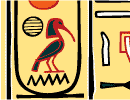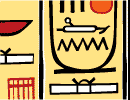LEARN ALL ABOUT READING
HIEROGLYPHICS: AN INTRODUCTION
Special thanks to Neferkiki for this wonderful introduction
So you want to write like an Egyptian, huh? Well it took several years for
aspiring scribes to learn how to do it, so for the sake of time we'll just cover
the basics.
Hieroglyphic writing is phonetic...
That means symbols stand for certain sounds (unlike the English
alphabet where some letters have many sounds or can be silent). Let's start out
with an example, the word freight. While the F, R, and T sound the
"normal" way, the G and H are silent and the E and I make one sound (long A).
There are 7 letters in the word, but only 4 sounds (F, R, long A, and T) are
heard. So to spell freight with hieroglyphs, you'd use the symbols for
those 4 sounds:
      
Four different sounds are used to say "freight," so four symbols-- no more,
no less-- are needed to write it the Egyptian way.
Our spelling is more complicated than it needs to be. Like, why do we spell
phone with a PH when we have a perfectly good F just going
to waste? And why bother with C when we already have K and
S? Why have double letters (like the M's in rummy) when we only
pronounce it once? And then there are words like knight,
technique, and phlegm! When you use hieroglyphs, you spell your
words phonetically (the way it sounds), so you leave out silent letters:
- height: the E,G, and second H are silent
- maybe: A and E are long, the Y is silent
- hey: the EY sounds like a long A
- Christmas: the CH sounds like K, the T is pretty much silent, and
the A sounds more like a short I
- rogue: the U and E are silent
- saxophone: the X is really a KS sound, the PH is an F sound, and
the E is silent
Alone or in pairs, vowels stand for lots of different sounds. And sometimes
they're silent. When any English letter (whether it's a vowel or a consonant) is
silent, don't include a hieroglyph for it.
Some English sounds weren't spoken in ancient
Egypt...
English and ancient Egyptian aren't from the same language family, so some of
the sounds they said don't exist in our alphabet. And some of the
sounds we make did not exist in Egyptian. For example, they didn't need a
hieroglyph for the TH sound because they didn't say any words containing
that sound.
You'll notice in the chart at the bottom that some sounds (like F and
V) that are different to us weren't distinguished by the ancient
Egyptians, so we have to use the same hieroglyph. Why F and V? Because these two
sounds are articulated in roughly the same place in your mouth. Try saying
"ffffff" and then change it to "vvvvvv." See how changing the flow of air in
your mouth makes a subtle difference in the sound?
Vowels were often left out...
The Egyptians often used only hieroglyphs for consonant sounds to write their
words. Thus, you can spell freight like this:
F-R-T or      
But is that freight, fort, or feret? You have to look at the word in the
context of the rest of the sentence to figure it out. Or you could use a
determinative...
Q: If you leave out the vowels, what does     (G-S) mean? (G-S) mean?
A: Either one. We can't tell unless a
determinative is written with the other hieroglyphs.
A determinative is a hieroglyph that has no sound. It's just there to give a
clue to the meaning of the word. Determinatives were tacked on to the ends of
words to indicate its general meaning:
The two determinatives above and the hieroglyphs listed below are just a
few of the thousands that were used by ancient Egyptians. Now you can
understand why it took several years for a scribe to learn how to write! But now
you should be able to at least write your name.
| Sound or
Letter |
Example |
Hieroglyph |
short A |
cat, bar |
 |
long A |
make, air, way,
hey |
 |
B |
baby |
 |
soft C |
nice, circus |
 |
hard C |
camel, sick,
Christmas |
 |
CH |
cheese, catch, picture |
 |
D |
dog, add |
 |
short E |
earn, pet |
 |
long E |
be, bleach, Mary,
radio |
 |
F |
fish, phone, tough |
 |
soft G |
gorgeous, gym, judge |
 |
hard G |
girl, ghost |
 |
H |
how, who |
 |
short I |
hid, bit |
 |
long I |
hide, bite, eye |
 |
J |
jungle, judge |
 |
K |
pick, kid, technology, clique |
 |
L |
lead, bell |
 |
M |
mummy |
 |
N |
Nile |
 |
short O |
dog, all, shawl |
 |
long O |
rose, sew, mow,
boat |
 |
OO |
food, blue |
  |
OO |
book, push |
 |
P |
pet |
 |
QU |
Q+U sounds like K+W, so combine the K and W hieroglyphics |
  |
R |
rain |
 |
soft S |
sit, nice, rats |
 |
sharp S |
fission, measure |
 |
z-like S |
rays,
loser |
 |
SH |
ship, sugar, mission,
friction, machine |
 |
T |
tiger |
 |
TH |
Egyptians had no sound for TH as pronounced in this and that.
Closest match is the D sound. |
 |
TH |
Egyptians had no sound for TH as pronounced in think and math.
Closest match is the T sound. |
 |
short U |
cut, about, ugly |
 |
long U |
rude, food, blue |
  |
V |
viper |
 |
W |
wind, what, cow |
 |
X |
examine |
  |
hard Y |
crayon, yes |
 |
vowel Y |
use hieroglyph for long E in words like ready and Mary |
 |
vowel Y |
use hieroglyph for short and long I in words like gym and byte |
 |
Z |
zebra, dogs, fission,
Xerox |
 |
|





